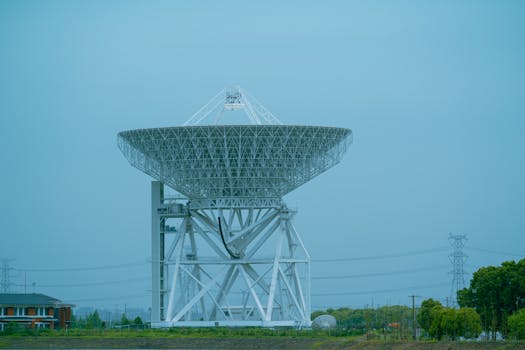Satellite Telecommunications 2023: What’s New and What’s Next? – Satellite Telecommunications

Satellite Telecommunications 2023: What’s New and What’s Next? Satellite telecommunications is a vital component of modern communication systems, enabling global connectivity and facilitating the exchange of information across the globe. The industry has undergone significant transformations in recent years, driven by advancements in technology, changes in consumer behavior, and the increasing demand for high-speed data services. In this article, we will delve into the latest developments and future trends in satellite telecommunications, exploring the innovations that are shaping the industry and the opportunities that lie ahead.
The satellite telecommunications industry is rapidly evolving, with new technologies and innovations emerging in 2023. One of the key trends driving the industry is the growing demand for high-throughput satellites (HTS), which offer faster data speeds and greater capacity than traditional satellites. HTS systems are being used to support a wide range of applications, including broadband internet, mobile communications, and satellite-based earth observation. According to a report by Euroconsult, the global HTS market is expected to reach $14.4 billion by 2028, driven by the increasing demand for high-speed data services and the growing need for satellite-based connectivity.
Another significant trend in the satellite telecommunications industry is the development of low-earth orbit (LEO) satellite constellations. LEO constellations consist of hundreds or thousands of small satellites that orbit the earth at an altitude of around 1,200 kilometers, providing global coverage and high-speed data services. Companies such as SpaceX, Amazon, and OneWeb are leading the charge in the development of LEO constellations, with plans to launch thousands of satellites in the coming years. The LEO constellations are expected to play a major role in the provision of global broadband services, enabling high-speed internet access to remote and underserved communities around the world.
The increasing use of satellite technology in the 5G ecosystem is also a key trend in the satellite telecommunications industry. Satellite technology is being used to support the rollout of 5G networks, providing backhaul services and enabling the extension of 5G coverage to remote and hard-to-reach areas. The use of satellite technology in 5G is also expected to enable a wide range of new use cases, including massive machine-type communications, ultra-high-definition video streaming, and immersive technologies such as virtual and augmented reality. According to a report by Ericsson, the use of satellite technology in 5G is expected to generate $1.3 billion in revenue by 2025, driven by the growing demand for high-speed data services and the need for low-latency connectivity.
In addition to these trends, the satellite telecommunications industry is also being shaped by the growing demand for satellite-based earth observation services. Satellite-based earth observation involves the use of satellites to collect data about the earth’s surface, including information about weather patterns, climate change, and natural disasters. The data collected by satellite-based earth observation systems is being used to support a wide range of applications, including environmental monitoring, agricultural management, and disaster response. According to a report by MarketsandMarkets, the global satellite-based earth observation market is expected to reach $5.6 billion by 2025, driven by the increasing demand for data and analytics and the growing need for satellite-based services.
As the satellite telecommunications industry continues to evolve, it is likely that we will see significant advancements in technology and innovation. One of the key areas of focus for the industry is the development of new satellite technologies, including the use of advanced materials and propulsion systems. The use of advanced materials such as graphene and nanomaterials is expected to enable the development of lighter and more efficient satellites, while the use of advanced propulsion systems such as electric propulsion and nuclear propulsion is expected to enable faster and more efficient satellite operations. According to a report by NASA, the use of advanced materials and propulsion systems is expected to play a major role in the development of future satellite missions, enabling the creation of more capable and sustainable spacecraft.
Another area of focus for the industry is the development of new satellite-based services, including the provision of broadband internet and mobile communications. The use of satellite technology to provide broadband internet and mobile communications is expected to play a major role in the provision of global connectivity, enabling high-speed internet access to remote and underserved communities around the world. According to a report by the International Telecommunication Union (ITU), the use of satellite technology to provide broadband internet and mobile communications is expected to generate $50 billion in revenue by 2025, driven by the growing demand for high-speed data services and the need for global connectivity.
In conclusion, the satellite telecommunications industry is rapidly evolving, driven by advancements in technology, changes in consumer behavior, and the increasing demand for high-speed data services. The industry is expected to continue to grow and evolve in the coming years, driven by the development of new satellite technologies, the increasing use of satellite technology in the 5G ecosystem, and the growing demand for satellite-based earth observation services. As the industry continues to evolve, it is likely that we will see significant advancements in technology and innovation, enabling the creation of more capable and sustainable satellite systems and supporting the provision of global connectivity and high-speed data services.
The future of satellite telecommunications is exciting and full of possibilities, with new technologies and innovations emerging all the time. As the industry continues to grow and evolve, it is likely that we will see significant advancements in areas such as satellite technology, 5G, and earth observation. The use of satellite technology to provide broadband internet and mobile communications is expected to play a major role in the provision of global connectivity, enabling high-speed internet access to remote and underserved communities around the world. The development of new satellite technologies, including the use of advanced materials and propulsion systems, is also expected to enable the creation of more capable and sustainable satellite systems, supporting the provision of high-speed data services and the growth of the global economy.






